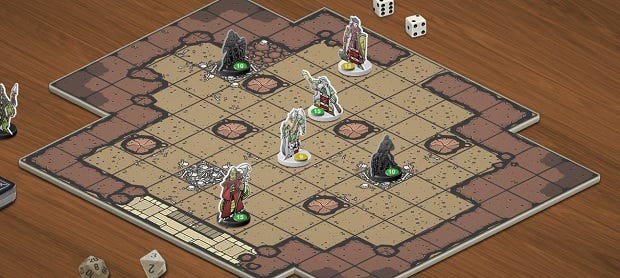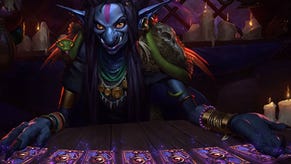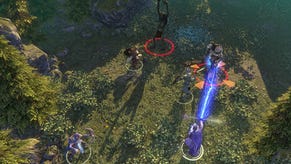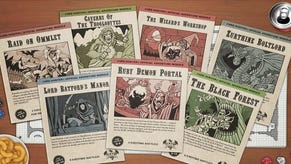Wot I Think: Card Hunter
A sweet deal
Unless you’re reading these words on a device that doesn’t allow you to play Flash-based browser games, there is absolutely no reason for you not to toddle into another tab and start playing Card Hunter right now. If you have a terrible time, you can always come back, read the rest of this post and then jump straight into the comments to tell me how incredibly wrong I am. The rest of the post, you see, is made up of paragraphs of praise for one of the finest games of the year.
Part deck-builder, part tabletop RPG and part turn-based tactical brilliance, Card Hunter isn’t as simple a thing as the rather unenticing title suggests. There are cards and it is imperative to hunt for them, but not in the manner of a frustrated dad trapped inside on a rainy day, with a deck a couple of kings short. In Card Hunter, cards are derived from loot. Each piece of equipment attached to a character adds a selection of cards to their deck. Broadly, cards allow for attack, defense, movement or short-term ability modifications.
A rusty old sword could grant three weak attacks, unlikely to penetrate a decently armoured foe, and may also carry the possibility of a fumble or a rare piercing strike. Conversely, a magical diamond-edged blade might grant five armour-shattering slashes while also occasionally slicing through the bearer’s own flesh, causing double-edged damage in both directions.
During combat, characters are vulnerable to the luck of the draw. It’s possible to have a mighty warrior spend an entire turn shuffling across the battlefield, unable to bring himself close enough to crush a gang of goblins with his Mallet of Mashing. Rather than frustrating, this adds to the pleasure of inventory management. It’s all well and good having an inventory stacked with high-powered melee attacks but they’re meaningless if the enemy can prance out of range, firing sparks and arrows, or skewering the heavy-footed heroes with polearms and spears. Balance is key, whether across the party of three or in the loadout of each individual.
After a few adventures, the loot stockpile is high, although it will probably contain a few duplicate items. Anything can be sold for a few coins but it’s worth hanging on to a diverse set of items so as to counter the specific threats of each of the game’s many quests. There’s an enormous amount of content, far more than I realised when I first created my account. Like everything else in the game, the map is a digital representation of a fictional tabletop RPG. It sits atop a table and clicking and dragging scrolls the screen across it, revealing lands far away from the kobold-infested corner where the game begins.
Apart from the portraits of the dungeon master siblings, which lack personality, Card Hunter’s aesthetic is delicious. Everything has been designed as if it were a copy of a real object. Quest briefings are printed on adventure sheets, with branding, logos and instructions listed. Characters are two dimensional cut-outs lodged in plastic stands and their depiction follows the logic implied by their physicality, as I noticed with delight when I first saw a fire elemental – rather than simply hovering above its stand, it was elevated by a strip of white card, holding it aloft.
There’s a level of commitment to the creation of this fictional game that I admire and the detail of every element makes even the most predictable fantasy tropes a pleasure to discover. As well as being a visually intelligent game, Card Hunter has a clever approach to narrative. While the mode of depiction makes even a zombie interesting, the two separate plotlines work together to make dungeon raiding intriguing.
Alongside the usual heroics of the player characters, there’s a slow-burning story of sibling rivalry between the games master and his older brother, who has his own ideas as to how unforgiving and sadistic a GM should be to his group. Kill ‘em all, he reckons, to teach them that life isn’t fair. Meanwhile, the hapless youngster messes up nomenclature and quest plotlines, becoming distracted whenever the pizza delivery girl arrives.
Some people may find it irritating that the player’s character is always (presumably) male, given the flustered reaction to a female presence in the game space, and that’s a fair complaint, but there’s a surprising nuance to the burgeoning romance. While the games master tries to hide the fact that he’s playing with miniatures and dice whenever she visits, the delivery girl just wants to be invited to play. She’s a gamer, locked out of the group because they’re too bloody pig-headed, introverted and stubborn to realise that she might want to spend time with the people they are rather than the ciphers they pretend to be.
Given the talent that worked on the game, it’s probably daft to be surprised that it unassumingly delivers a nostalgic, comic and thoughtful tale, in brief and easily ignored snippets of dialogue. If you care to engage with it, the text of Card Hunter has something to say about awkward adolescence, the sociability and insularity of gaming groups, and how personality can define the way we play together. It’s a far better proposition than the series of geek references and jokes that I expected.
The combat itself, which is the heart of the game, is superb. At first, it seems simplistic, with few obstacles carving up the maps and monsters that walk forwards and then die by your swords and spells. As different abilities are introduced and maps become more cluttered, wizards and priests must be positioned with care, as their spells can only buff and bludgeon figures that are within range and line of sight.
At the beginning of each round, each character receives a hand of cards from the individually assigned deck determined by the items equipped during the planning phases. No replacements are dealt until the round ends, which only happens when both the player and the GM pass. Two cards can be kept and the rest are discarded, so unless there’s an unpleasant trait that a character would rather be rid of, it can be best to take action rather than waiting for the perfect moment. Traits must be played as soon as they are drawn and they have various effects, from removing a character’s ability to make killing blows (squeamish) to automatically teleporting him/her to a new location at the beginning of each round.
Even if defeated, characters don’t die, instead simply removed from that particular adventure, leaving their companions to fight on alone. Some quests have victory points, locations that can be held to earn points toward a set total that grants success, but most just involve eradicating the opposition. There’s a great deal of variety in the opponents faced but I won’t spoil their behaviour here - exploring the map, and realising how much there is to see and to kill is one of the game’s great pleasures.
Completing an adventure, each of which contains several battles, unlocks new locations. Most of these are further adventures, but there are also shops, which restock daily or weekly, and special treasure hunts that grant unique loot. These, along with some character reskins, are the only specific unlocks that require actual cash expenditure. Skipping them does not prevent progress and by the time I completed the first, I already had better equipment than the item I won at the end of it, so I doubt they’ll even speed progress particularly. It’s also possible to buy membership in monthly instalments. Members receive one extra piece of random loot at the end of each adventure.
I’d hope that people will come to the game because of its quality and then feel happy subscribing or buying the Basic Edition, which provides access to all of the special treasure adventures, nine figures (cosmetic only), 100 slices of in-game currency and a month of membership. The in-game currency doesn’t provide boosts or unlock anything other than cosmetic items, further months of subscription or additional treasure hunts that may be added at a later date.
Card Hunter is an enormous, accomplished and complete game before a penny is spent. I’m excited to see it grow, even though I haven’t finished all of the launch content yet despite spending three days doing little else but playing. I haven’t had to grind either, although it is possible to replay adventures after a cool-down period. When I find myself struggling, I switch equipment and try again, and eventually, the breakthrough comes.
Every minute that I play, I’m considering options, cursing or cheering as cards come into play, and learning new tactics. Don’t stay away because its free-to-play – from the player perspective, this is the ideal of that model. I just hope it works as well for the creators as it does for me and that the generosity and lack of paywalls and nagging hindrances doesn’t prevent people from parting with their cash. deserve profit as well as acclaim, and Card Hunter is perfectly suited to expansions. I’d be happy if it kept growing for years.
By creating a game that mimics the tactility of a tabletop experience, Blue Manchu also present the rules of ever encounter and skill up-front, though without drowning the player in numbers and stats. Even the interface is commendable, quietly displaying the relevant equipment for each character class and inventory slot as the contents of treasure chests, inventories and shops are explored. It’s as good a turn-based skirmish game as I can remember any studio releasing in a good while, exquisitely presented and mechanically solid.
Go and play Card Hunter now! I'll share thoughts on multiplayer soon.



















